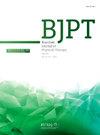Experiences of physical therapists applying telerehabilitation to neurological patients: A qualitative study
IF 3.2
3区 医学
Q1 ORTHOPEDICS
引用次数: 0
Abstract
Background
Telerehabilitation has been widely used in neurological diseases in recent years. The experiences of physical therapists and the difficulties they face are critical to the effectiveness of telerehabilitation.
Objective
To examine in depth the technical challenges, patient interaction strategies, and session management processes faced by physical therapists who use telerehabilitation for patients with neurological conditions and to assess the opinions of physical therapists about the advantages, disadvantages, technological infrastructure needs, and support strategies of telerehabilitation.
Methods
In this study, phenomenological qualitative research method was used. In-depth interviews were conducted with eight physical therapists who treated patients with neurological disorders with telerehabilitation in our country. Interview data were analyzed using content analysis.
Results
The analysis revealed seven key themes and 26 sub-themes, which were categorized into two main areas: telerehabilitation session management and perceptions of telerehabilitation sessions. In the area of session management, physical therapists reported challenges related to the adaptation of traditional rehabilitation techniques to the online environment, including difficulties with assessing patients' physical conditions remotely, ensuring patient engagement, and managing technical issues such as internet connectivity and software limitations. They also highlighted the importance of clear communication, structured session planning, and the need for additional training to effectively conduct telerehabilitation sessions.
Conclusions
Considering the advantages and disadvantages stated by physical therapists using telerehabilitation with patients with neurological conditions, solutions should be developed to increase the efficiency of telerehabilitation. Applications with simple interfaces, a home environment suitable for exercise sessions, and strategies to support technology adaptation can significantly improve the efficiency of telerehabilitation.
物理治疗师应用远程康复治疗神经系统病人的经验:一项定性研究
近年来,远程康复在神经系统疾病中得到了广泛的应用。物理治疗师的经验和他们所面临的困难对远程康复的有效性至关重要。目的深入探讨物理治疗师对神经系统疾病患者进行远程康复的技术挑战、患者互动策略和会话管理过程,并评估物理治疗师对远程康复的优势、劣势、技术基础设施需求和支持策略的看法。方法本研究采用现象学定性研究方法。对我国8名从事神经系统疾病远程康复治疗的物理治疗师进行了深度访谈。访谈数据采用内容分析法进行分析。结果共划分出7个主要主题和26个次主题,分为远程康复会话管理和远程康复会话感知两个主要领域。在会话管理领域,物理治疗师报告了与传统康复技术适应在线环境相关的挑战,包括远程评估患者身体状况的困难,确保患者参与,以及管理诸如互联网连接和软件限制等技术问题。他们还强调了明确沟通、有组织的会议规划的重要性,以及为有效开展远程康复会议而进行额外培训的必要性。结论考虑到物理治疗师对神经系统疾病患者进行远程康复治疗的利弊,应制定提高远程康复效果的解决方案。具有简单界面的应用程序、适合锻炼的家庭环境以及支持技术适应的策略可以显著提高远程康复的效率。
本文章由计算机程序翻译,如有差异,请以英文原文为准。
求助全文
约1分钟内获得全文
求助全文
来源期刊
CiteScore
6.10
自引率
8.80%
发文量
53
审稿时长
74 days
期刊介绍:
The Brazilian Journal of Physical Therapy (BJPT) is the official publication of the Brazilian Society of Physical Therapy Research and Graduate Studies (ABRAPG-Ft). It publishes original research articles on topics related to the areas of physical therapy and rehabilitation sciences, including clinical, basic or applied studies on the assessment, prevention, and treatment of movement disorders.

 求助内容:
求助内容: 应助结果提醒方式:
应助结果提醒方式:


